THE WAR INDUSTRY PLANS WORLD WAR III
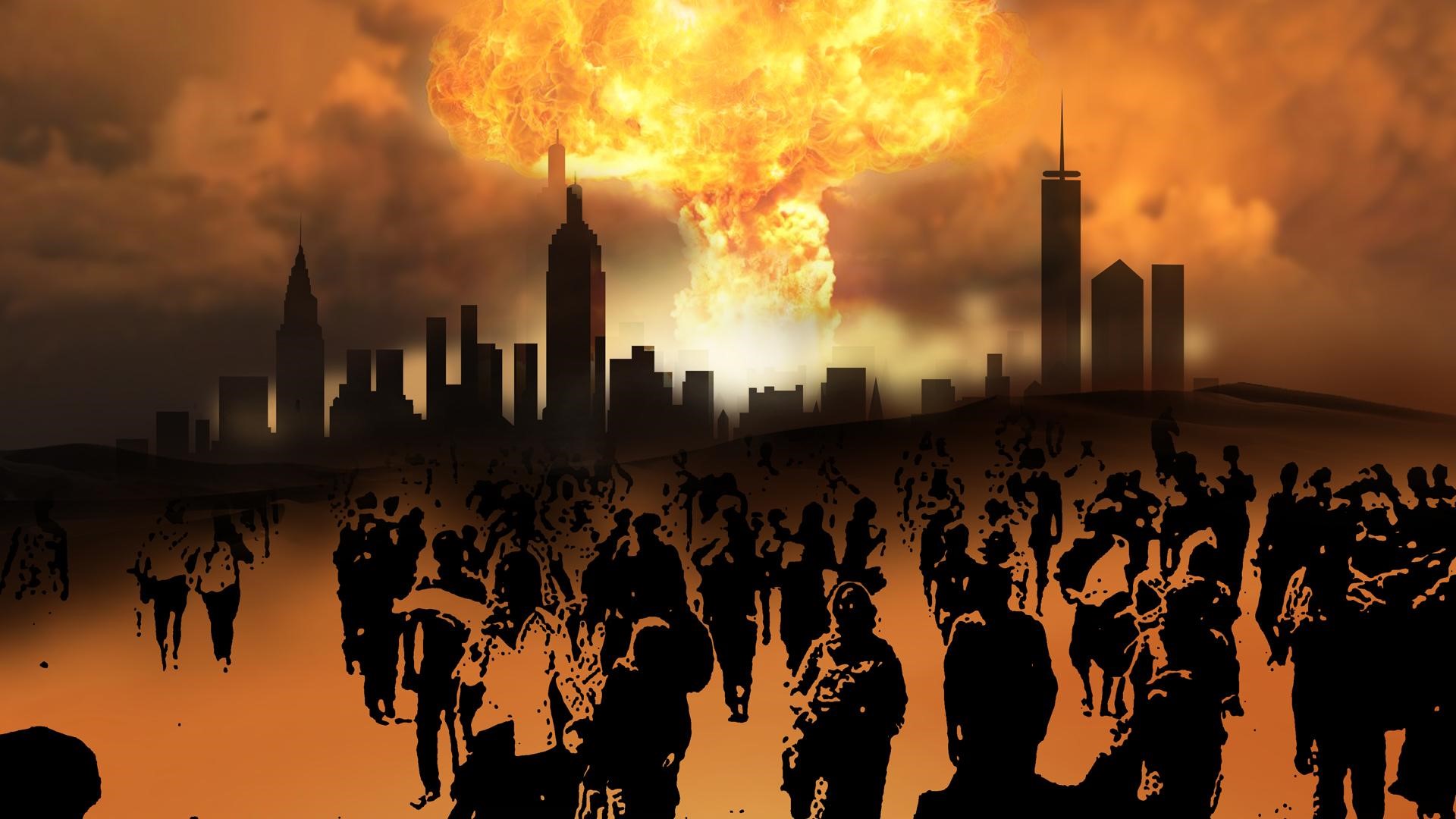
The Kremlin immediately branded the article a hoax, but the German newspaper Bild wrote on 15 January that secret NATO documents predict a war with Russia[1] as early as the summer of next year. It may be a hoax, one hopes, but the fact is that NATO has meanwhile planned the largest military exercise[2] in Europe since the end of World War II. The exercise is called Steadfast Defender 2024 and will last until May.
If it is not next year, total war with Russia will still take place in the next 20 years: Military Committee Chairman Rob Bauer said it outright on 19 January[3] : ‘Civilians must prepare for total war with Russia in the next 20 years. We see Russia as a threat, and we must be ready for an attack. We need an industry that produces weapons and ammunition faster’.
The armed forces are already prepared for battle, but according to Bauer, the civilian population is not. This is why the latter must start preparing now, also because such a war would require a radical change in everyone’s lives. Including therefore also ours…. How one should prepare remains a mystery, as if it were an irrelevant detail. The important thing is to wage war, the rest, i.e. the civilian population, comes later. As Marshal Charles De Gaulle, and perhaps Napoleon before him, used to say, ‘the stewardship will follow’.
The Cassandras’ race to predict when such a war will break out also points to other dates. For German Defence Minister Boris Pistorius, it is to be expected within five to eight years. For Norwegian Defence Minister Eirik Kristoffersen[4] and Estonian Prime Minister Kaja Kallas[5] the conflict could materialise sooner, within three years.
Let us leave in the postscript at the end of this article the explanations as to why the fear or rather the certainty of a Russian invasion[6] of Europe as a continuation of the invasion of Ukraine is groundless. If only because the US alone spends 12 times[7] what Russia spends on its armed forces. If we then add to US military spending that of the EU and the UK, there is really no comparison: Russian military spending becomes almost negligible. Not to mention that while all around Russia there is a flood of NATO and US bases, military fleets and aircraft carriers equipped with atomic bombs, Russia on the other hand has very few military bases abroad, only a couple outside former Soviet Central Asia.
So it can only do devastating reprisals from a few submarines or with intercontinental missiles. But it can certainly never hope to invade the USA or England or Western Europe, let alone maintain their occupation. Under these conditions an attack by Russia on Europe would surely and clearly be suicide. But then why this sudden and insistent drumbeat and blaring of military trumpets, cries of “Wolf! Wolf!” and heart-pounding alarms?
The necessary enemy

US fleet aircraft carriers manning the Mediterranean Sea[8]
The answer is simple. The United States, in order to justify its colossal military expenditures, has needed since the end of World War II what has at some point been called the Necessary Enemy: identified hand in hand in the USSR and the annexed ‘cold war’, in Korea, Vietnam, Cuba, Grenada, Iraq, Afghanistan, Syria, Iran, now Yemen. Something similar is happening in Europe, which has to somehow justify the huge sums spent to support Ukraine in the war and the consequent increase in military expenditure caused by the continuing Russian-Ukrainian war, with the accompanying damage to the economy.
Let us therefore see how the figure of the Necessary Enemy was born and how it has grown. With the associated enormous development of military industry and scientific research and their ability to drive the development of civil production to such an extent that the expression ‘warfare’ was born as the heir or complement to ‘welfare’.
On 17 January 1961, three days before the inauguration of John Kennedy as the new US president, in his farewell address to the White House after two terms in office, President Dwight Eisenhower, addressing the entire nation, wanted to warn the public[9] of the danger implicit in secret agreements between political power, the war industry and the military: ‘A vital element in the maintenance of peace is our military institutions. Our weapons must be powerful, ready for instantaneous action, so that no potential aggressor can be tempted to risk his own destruction. […] This conjunction of an immense body of military institutions and an enormous arms industry is new in the American experience.
Eisenhower continued: ‘Total influence in the economy, in politics, even in spirituality is felt in every city, in every state body, in every office of the federal government. We recognise the imperative need for this development. However, we must not fail to understand its grave implications. Our philosophy and ethics, our resources and our way of life are affected. And so is the backbone of our society. In government councils, we must guard against the acquisition of influences that do not give guarantees, whether overt or covert, exerted by the military-industrial complex. The potential for the disastrous rise of powers that override their seat and prerogatives exists, now, and will persist into the future’.
Eisenhower concludes: ‘We must never allow the weight of this combination of powers to endanger our freedoms or democratic processes. We must not assume that no right is given for granted. Only an alert and knowledgeable citizenry can exercise an appropriate trade-off between the enormous industrial and military defence machine and our peaceful methods and long-term objectives, so that both security and freedom can flourish together’. Coined by a career military man, a veteran of the Second World War and the US presidency, the expression ‘military-industrial complex’ was thus born.
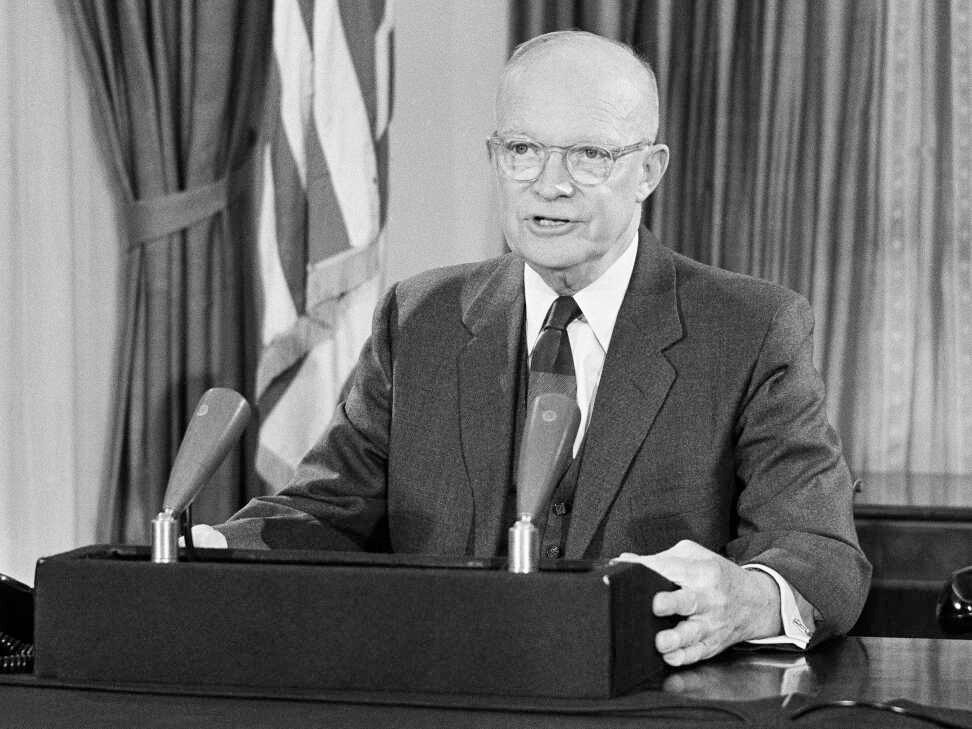
17 January 1961: President Dwight Eisenhower in his farewell address at the White House[10]
At the end of the Second World War, the importance of the military reached its peak, favoured to a large extent by the conditions that at the end of the conflict served as objective premises for the Cold War policy. US military expenditure in the course of the conflict against Japan, Germany and Italy had increased sixfold: between 1940 and 1945, the US spent no less than $185 million on tanks, planes, ships, and every other type of war material. This gave a considerable boost to the country’s economy.
The share of military expenditure in the North American GDP – which had grown between 1939 and 1944-45 from about $90 billion to $200 billion – increased significantly from an insignificant 1.5 per cent in 1939 to almost 40 per cent in 1944-45. Against this backdrop, relations between the arms-producing monopoly groups and the long-established politico-military bureaucracy underwent an unprecedented upsurge, not least due to the Cold War climate that emerged with the end of the Second World War. This gave rise to what is commonly referred to as ‘Military Keynesianism’, ‘War Economy’ or ‘Pentagon Economics’.
During the two World Wars, the system of ties and links between the monopolies and the political-military bureaucracy, closely linked to the organisation and functioning of the industrial-military apparatus, had been defined, which represented a first-order assumption for acting in wartime circumstances, but whose constraints achieved – at the same time and contrary to other earlier phases of capitalism – ceased to be of a conjunctural nature imposed by momentary political-military crises. And they became a phenomenon that increasingly began to form an integral part of the general functioning mechanism of capitalist reproduction. In other words, arms and war production in general was beginning to form part of the capitalist reproduction mechanism in a structural manner. It was strongly stimulated by the advantage for the industrial-military groups of being able to produce at the expense of the federal state budget.
In the specific case of the United States, once the war phase was over, a sufficiently solid industrial infrastructure remained to serve as an instrument of defence or as a means of ‘keeping the peace’ or, as happened after the Second World War, as an instrument to support the hegemony achieved by the United States. This hegemony was reinforced when, almost towards the end of the Second World War, then-President Harry Truman decided to launch nuclear devices on the Japanese cities of Hiroshima and Nagasaki, under the pretext of bringing the war with Japan to a swift end.
In reality, he did this to send a message of nuclear blackmail to the USSR. This latter opinion is shared by an increasing number of specialists. In turn, in the subsequent era of the Cold War proper, the actions directed at reinforcing the North American (already then nuclear) military capability by all the European powers, still colonial imperialists, were harmonised and driven by the quest for strategic superiority over the USSR. This became a central theme of political discourse.
From then on, the Soviet Union emerged as the main focus of US military – and in particular nuclear – policy: the ‘necessary enemy’ was born. The Korean War, in which the US was engaged for three years, from 1950 to July 1953, was a further stimulus for the expansion of civil industry as well. So much so that the National Security Council, the highest body supporting the US president in matters of national security and foreign policy, issued directive number 68 (NSC68): 66 pages entitled ‘United States Objectives and Programs for National Security’[11] and remained secret until 1975. The directive recommended increased spending in the military sector because (also) the Korean War had shown that the growth of this sector had been a driving force for the development and growth of civil industry and production. In summary, the National Security Council recommended the policy of continuous rearmament[12] .
From Welfare to Warfare
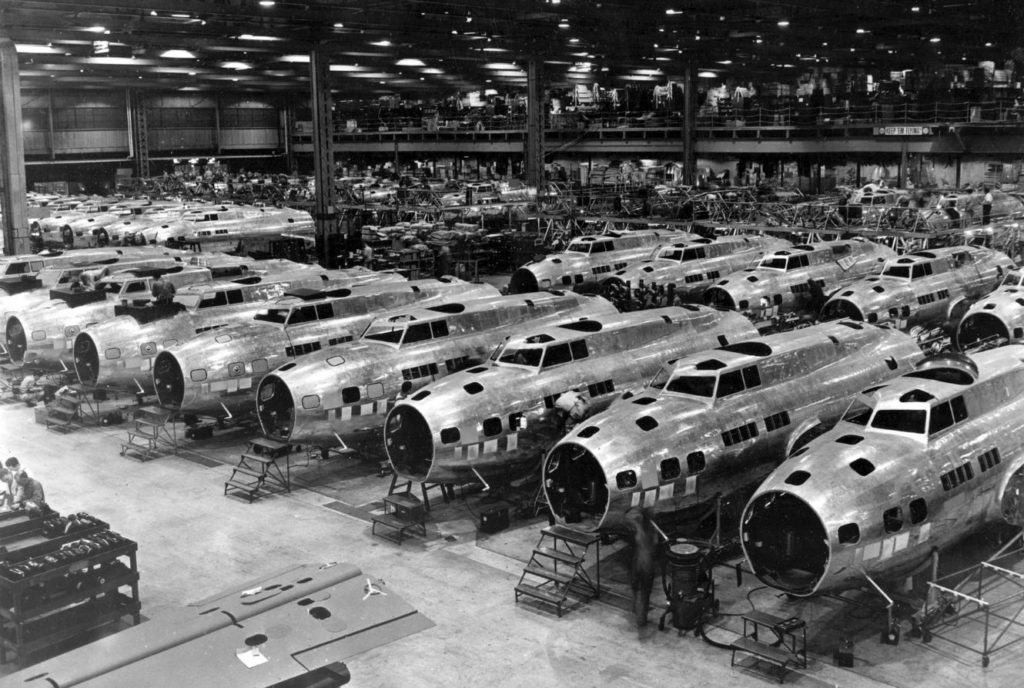
March 1940: the productivity of the US war industry reaches hitherto unthinkable levels [13]
The size of the US public investment in military R&D is indicative of the phenomenon as a whole. In 2008, 30 per cent of all scientists ‘and engineers working in industrial R&D were working in areas related to military activities, slightly less than 50 per cent of all expenditure classifiable as ‘R&D’ in the US was supported by the federal government, and about two-thirds of all federal R&D expenditure went to activities related to the Pentagon.
Ultimately, this means that about 30% of US domestic R&D expenditure went to military programmes. At the same time, about 40% of all world spending on ‘Research’ was spent on ‘Military Research’. The number of scientists and engineers working on military programmes worldwide in 2008 was around 400,000, which is about 40% of the global total of all active scientists and engineers. Percentages that increase if we then limit ourselves to the categories of physicists and engineers. Percentages and figures that have gradually increased since 1998 due to the great development of countries such as China, India, Brazil, Turkey, Iran, Israel, Saudi Arabia and the Arab Emirates.
But how did it come to this?
To overcome the Great Depression of 1929, Franklin Delano Roosevelt’s New Deal policy had actually only achieved partial economic results. Four years after the launch of the New Deal, in 1937, the US was again in the midst of an economic crisis. What saved the US economy – and was the real engine that brought the US out of the Great Depression – was their entry into the war in 1941 after Japan’s attack on Pearl Harbor, an attack that was most likely left unleashed in order to have a good motivation to push public opinion to war.
Boosted by war necessities, US government spending grew enormously. And the US economy began to function at full capacity. Once the war was over, the discontinuation of war production and subsequent demobilisation produced a new recession. This time the US was saved by the start of the Cold War, which quickly took on the character of military confrontation and an arms race.

July 2021: NATO’s massive military exercise in the Black Sea, named ‘Sea Breeze’[14]
The presence of atomic weapons – at first only American and since 1949 also Soviet – has added to this rearmament a character of exceptional gravity. In the era of the Cold War, the actions of all the Western powers, the USA in the lead, were aimed at increasing military capabilities fuelled by the quest for strategic superiority over the USSR. Which has since emerged as the main theme of US military policy – especially nuclear policy -: the ‘necessary enemy’.
The ensuing madness fuelled by the Cold War led the US to produce tens of thousands of atomic bombs of all kinds, ever more powerful, and then also ever more miniaturised so that they could be used as almost ‘normal’ devices. Thus the Soviet Union was forced into an eternal scramble to do the same. With the inevitable queuing up of all countries that had access to nuclear capabilities: from Britain to China, from France to India, from Israel to Pakistan.
However, a large military-industrial complex cannot justify its existence except by exercising the role for which it was built, namely that of an instrument of military policy. This explains why the war in Vietnam, and the consequent increasing weight of the military establishment and the war industry in US politics. In the long run, however, this type of expenditure is a handicap for the star and stripes economy for various reasons, first and foremost the loss of efficiency it entails. The military sector is protected from market uncertainties because profits are guaranteed, and it is normal to raise costs if commitments are long-term.
Such aspects, moreover, guarantee a certain demand for the companies involved in production, because they do not have to scramble to constantly renew themselves to face the future. But, in reality, all this is also an ideal situation for fuelling inefficiency, theft and waste. All of which, added to the rigid bureaucracy of the sector, constitute a considerable burden on the economy. A burden that becomes a loss of competitiveness and productivity.
As if that were not enough, the lure of being able to work in large scientific-technological enterprises makes it clear that military R&D entails a real drain of brains and resources from the civil sector.
Post Scriptum
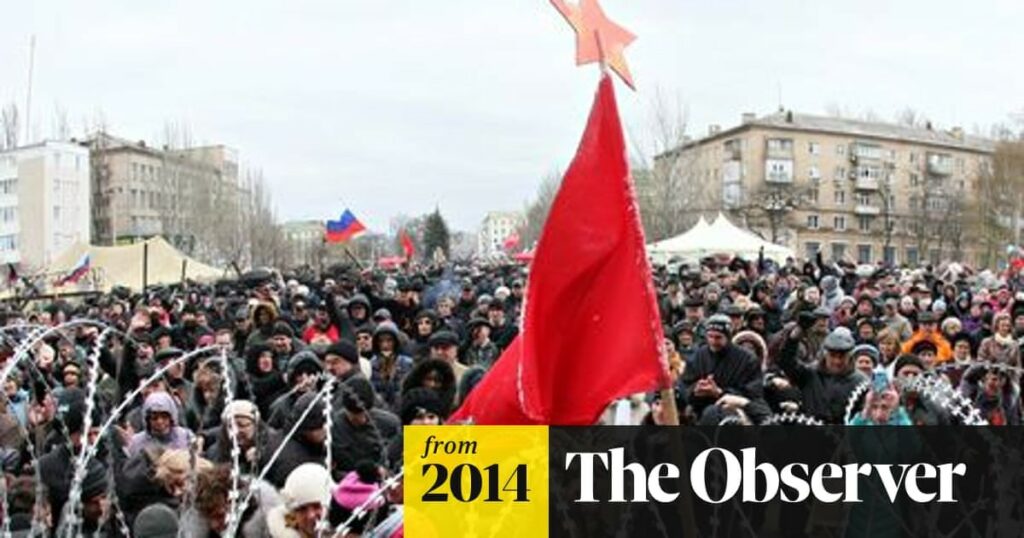
12 April 2014: Demonstrators in Donetsk demanding the annexation of the Donbass to Russia[15]
At least officially, Russia has invaded Ukraine to put an end to the Kiev government’s aggression and discrimination against the rugged Russian-speaking minority in the eastern Donbass, hostilities that began in 2014 and were the cause of that minority’s decision to proclaim two small autonomous people’s republics. Autonomous, but not yet secessionist. This proclamation was also opposed by Kiev with weapons, especially with extreme right-wing paramilitary gangs such as the notorious and infamous Azov, the lesser-known Pravi Sector (in Italian, Settore Destro) and others, thus triggering a civil war with a few tens of thousands dead.
As for Crimea, no invasion was necessary: it was enough to hold a referendum in which the large Russian-speaking majority decided to separate from Ukraine and become part of the Russian Federation again. Of which Federation it was part until Ukrainian Nikita Khrushchev, a year after succeeding Joseph Stalin at the helm of what was then the Union of Soviet Socialist Republics (USSR) in 1953, decided to administratively merge it with his beloved Ukraine, which was part of the USSR.
In the Eastern European states that were members of the USSR until its dissolution on 26 December 1991, there lived not insignificant Russian-speaking minorities: all of them disliked by their respective governments and often also by a large part of the rest of the population. This being the case, it cannot be safely ruled out that Russia will not be forced to defend those minorities even with military interventions, however decidedly unlikely for a whole series of reasons. The most important of which is that Russia spends only a small fraction of what the US and EU spend on the armed forces, resulting in an army that, as the war in Ukraine has also shown, is better suited to the defence of its own territory than to the invasion of other people’s territories.
History shows that Russia, invaded by Napoleon’s Swedes, Napoleon’s French, Hitler’s Germans and Mussolini’s Italians at appalling human cost and large-scale destruction, never attempted to invade Europe. If it came to exercise political-military hegemony over Eastern European states, it was only because, invaded by Nazi Germany and Fascist Italy in World War II, it first resisted and then fought back by repelling the invaders as far as Berlin.
After the war, it entered into the Yalta Pact with its Anglo-American allies, by which Europe was divided into two spheres of influence: Western Europe in the US sphere of influence, with the subsequent and consequent military version known as NATO, and Eastern Europe in the Soviet sphere of influence, with the consequent military version known as the Warsaw Pact, NATO’s opposite and antagonist. Until the death of the Soviet Union brought an end to Soviet influence and the Warsaw Pact.
USA007
[1] https://www.ansa.it/sito/notizie/mondo/2024/01/15/documento-segreto-tedesco-con-lo-scenario-di-una-guerra-russia-nato_7c918e97-1965-4854-9fbe-5565bb3a154f.html
[2] https://www.corriere.it/esteri/24_gennaio_18/nato-esercitazione-militare-attacco-russo-999d6aec-b625-11ee-8131-eee5ee6b3690.shtml
[3] https://www.ilmessaggero.it/schede/nato_guerra_totale_russia_presidente_del_comitato_militare_cosa_dice-7882020.html
[4] https://www.lastampa.it/esteri/2024/01/22/news/la_russia_in_guerra_con_leuropa_nel_giro_anche_di_tre_anni_lallarme_del_capo_della_difesa_norvegese_il_tempo_a_nostra_d-14012712/#:~:text=The%20same%20day%20as%20the%20minister%20without%20German%20passport%20in%27the%27army
[5] https://www.ilmessaggero.it/schede/putin_attacco_nato_guerra_mondiale_russia_allarme_estonia_cosa_sappiamo-7877324.html
[6] https://www.eunews.it/2024/01/22/ue-nato-preoccupati-attacco-della-russia/
[7] https://www.ansa.it/sito/notizie/cronaca/2022/03/31/spesa-militare-nel-mondo-dominano-gli-usa_3505abb8-048b-4dc4-b725-c62c38f301fb.html
[8] https://www.repubblica.it/esteri/2019/04/25/news/mediterraneo_america_russia-300994126/
[9] t https://history.state.gov/milesones/1945-1952/NSC68
[10] https://www.npr.org/2011/01/17/132942244/ikes-warning-of-military-expansion-50-years-later
[11] https://it.alphahistory.com/guerra-fredda/dwight-eisenhowers-discorso-d%27addio-1961/
[12] https://www.rizzolieducation.it/news/le-grandi-potenze-in-corea-nel-1950/
[13] https://warontherocks.com/2017/12/hedging-bets-reviving-defense-industrial-surge-capacity/
[14] https://www.repubblica.it/esteri/2021/07/02/news/mar_nero_stati_uniti_esercitazioni_sea_breeze_2021_acque_di_tutti_internazionali_libere-308512549/
[15] https://www.theguardian.com/world/2014/apr/12/east-ukraine-protesters-miners-donetsk-russia


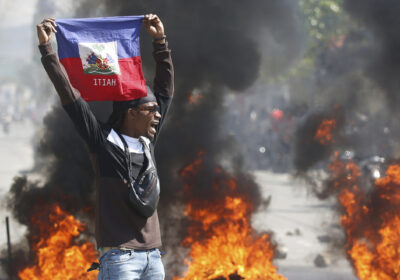
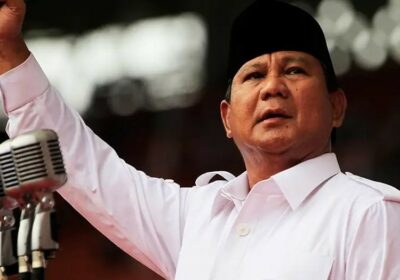
Leave a Reply